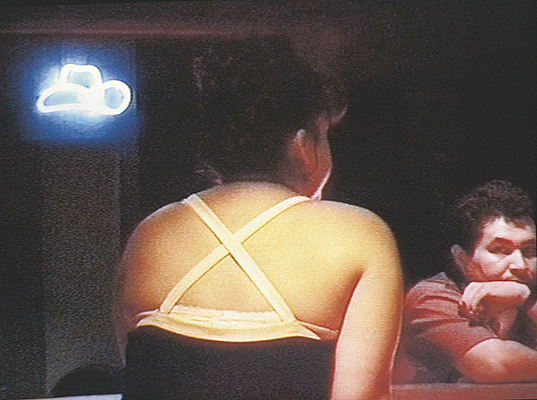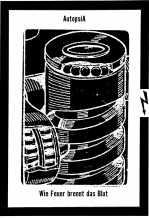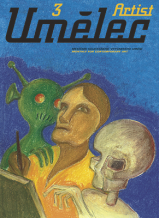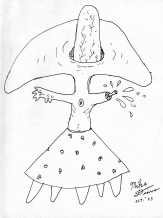| Zeitschrift Umělec 2000/6 >> At the Edge of Impermanence | Übersicht aller Ausgaben | ||||||||||||
|
|||||||||||||
At the Edge of ImpermanenceZeitschrift Umělec 2000/601.06.2000 Jeffrey A. Buehler | focus | en cs |
|||||||||||||
|
“Borderhack! does not pretend to destroy the border, but, in a worst case scenario, only to make us conscious of it. In the world of computers, hacking is understood as the penetration, exploration or investigation of a system with the goal of understanding it, not of destroying it, and that is exactly what we are trying to do: to understand the border, to know what it represents and to become aware of the role that we play in it.”
Excerpt from the Borderhack! Manifesto in Tijuana at the Mexican-American border There are many ways to approach a border, if crossing it is your intention. But how does your impression of a border region change when you stop to look more closely at the very nature of the space and the lives and land it encompasses. Settle into the artificial world along the Mexican-American border where life nevertheless goes on, performed in an imaginary space but with all too real consequences. Three recent projects singularly articulate the intensity of that space and its attendant consequences. The event Borderhack! confronted the physical border itself in Tijuana last September with multi-media savvy that included net art, border cinema, ISDN connections, conferences and workshops, as well as the participation of the global hacktivist and net-media art community. Witness Mexican women in Ursula Biemann’s video Performing the Border moving north to work in the corporate environment of the maquiladores in order to send money home to relatives. Only instead of opportunity, they wind up ensnarled in the vicious rhythms and regulations of the corporate machine apparatus at Ciudad Juarez. And photographer Mirjam Wirz has recently finished a project near the Rio Grande that probes the empty spaces in and around the border, on both sides, opening up and exposing the ambiguous relationships the natives, both Mexican and American, have to the region. “We cannot really be identified with Mexico, and even if we are ‘bordercrossers’ we know we are not really part of the US. We are something in the middle, just don’t know what.” Excerpt from the Borderhack! manifesto. On the first weekend of September 2000, a small group of students, artists, and activists put on an event in Tijuana that challenged the very notion of the physical border between Mexico and the United States. The event, Borderhack!, was the North American import of kein mensch ist illegal (no one is illegal), a European campaign that focused on hiding and supporting illegal migrants, squatting in churches, organizing public debates on illegal border crossing, and starting actions against deportations. A Germany-Poland border festival was formed in 1998 where activists and artists could express their outrage towards the treatment of illegal immigrants. Despite several attempts by the police to cancel the event in Germany, cyberculture personalities, artists, musicians, activists and human rights supporters successfully organized marches, talks, concerts, and workshops. The mix-media group Laboratorios Cinemátic, old hands in the promotion of cyberculture and electronic music, decided to take the concept to Tijuana but to apply what Luis Humberto Rosales, one of organizers, calls “a little reverse engineering.” Because of the delicate nature of this “border turned war zone” and the danger involved, the approach of the weekend was based on art and technology. But it was also unique for the undercurrents of humor, irony and anger that seemed to typify every aspect and moment in the camp, and which help elucidate Rosales’ comment: “We decided to deconstruct the different aspects of our border life, learn how it works and do something with it.” Activists and artists set up camp for three days at the long arm of fence — constructed from old Gulf War trash — which extends out into the sea. Fabian Torres, a local artist and hacker, projected onto the fence the names of the first 400 people who died trying to cross the border after the US government started Operation Gate Keeper in 1995. A series of documentaries showed what could be done with an Internet connection or other alternative media. The weekend at times became tense. In a performance piece dubbed “hacking,” several people throughout the weekend illegally scaled the fence, taunted the border patrol on the other side, and then jumped back again before they could be arrested. At one point the police intervened and tried to shut down the camp, arresting two “migrants” who were reporting what was happening on the Internet. The Internet played a vital role. Free Internet access and long-distance phone services allowed families that had been separated to communicate. On Sunday, in one of the best moments of the weekend, a moment that epitomized both the wit and the sincerity of the participants, a conceptual game of soccer was played in which one team represented the US and the other team the migrants. The migrants’ goal was made of women’s underwear and road signs. It was huge compared to the small US goal, which was placed directly against the border fence. The rules weighed heavily in favor of the US team. The project was created by Spanish artist and activist Jose Osfavelados. Conceptual aspects of the divisions separating the two countries, were reconstructed as a game, a game that could be played endlessly, in which there is a definite winner and a loser, the rules flexing according to hidden sources of power. In this case, despite the odds, the “migrant” team, with much trial and laughter, kicked more goals. Performing the Border “Nothing is natural in Ciudad Juarez. Everything is under the dictate of the pan-capitalistic machine.” Yvonne Volkart Ursula Biemann interviews a young Mexican woman in front of a rosebush in Ciudad Juarez, on the Mexican side of the border. She wears tight jeans for the video camera: At sixteen she moved to the North, had relatives in the border town Juarez, found work in one of the countless plants (known as the maquiladores or “golden mills”). What was left over from the pay she sent to her parents in the arid back country. Her face turns up and then away from the camera. They all moved to the North in the 70s into the maquiladores in the borderland between the first and the third world, over two million female Mexican hands soldering semi-conductors for global electronics. Her face moving away, Biemann asks: What does cultural identity have to do with optimizing production in the monetary West? What does cultural identity have to do with red and green ribbons in the hair? What meaning can cultural identity have in the globalized production of new technologies: electronic communications, media, hyper-mobility, computer animation, artificial intelligence, cyber-entertainment? And the video begins: Bertha Jottar, video artist and activist, comments in a voiceover while Concha drives through the desert. Concha is a “coyote,” famous for her ability to pass “wetbacks” over the border into the United States, especially pregnant women hoping to give birth in the US for citizenship. The camera hovers over her shoulder, her hand visible on the steering wheel, the dry mountain ridges cutting across the screen. Bertha: “You need the crossing of bodies for the border to become real, otherwise you just have this discursive construction. There is nothing natural about the border. It’s a highly constructed place that gets reproduced through the crossing of people....” The low, box-shaped buildings of the maquiladores fly by outside the car window. Women emerge from buses early in the morning and disappear behind fences and past a security guard. Later, there is an image of a long sterile room where women in lab coats are leaning over a table, physically blending into the high-tech gadgetry they are working on. Attracted by cheap labor opportunities, U.S. industry began installing plants for the production of high-tech equipment on the Mexican side of the border. Within a short time young women began moving north to look for opportunities, and choices. They came and built shacks to live in from the discarded trash of the maquiladores, “right into the desert sand.” Corporations wanted young women because they worked hard, had nimble fingers and caused fewer problems than men did. Before long a kind of shift took place. The border became what Biemann calls a highly gendered region, as women gained buying power. There were ruptures in the cultural patterns of power relations between men and women and the entertainment industry responded by catering to its female customers. The camera observes them from a passive distance: the early morning bus journey to work, love songs on the radio, dancing at night, walking away down a hot dusty street under an umbrella. Questions and voice-overs weave their way through what now feel like the monotonous motions of corporate machinery. Flexibility becomes a means of survival in an alien world rife with contradiction, where women work in a corporate environment during the day and knead el maiz at night. Where, in a blurring of cultural distinction, men have been supplanted by single young women, where mobility and consumption are the privilege of a the male-dominated corporate management in the North, denied to the feminized, labor-intensive South. Here the female body is emphasized, drawn out and examined. A female body in the maquiladores is a number, a body within the confines of its controlled, registered environment, a cyborg body in its efficiency, new language and behaviors, stripped of past and future. Bodies fall into the rhythm of the machines of high-tech capitalism, and are thus controlled, registered, and dehumanized. And the body is what is sold at night, on the weekends, after the plants have closed. Not all of the women are accepted into the maquiladores so some have to find work as maids in private homes, but without references the women resort to prostitution. In a question that unbraids neatly a tangled web of issues, the viewer is asked, almost intimately: How do you feel about the three options? Since 1993, 124 bodies have been found in the desert, all of them representing violence against women. In a distorted image, a cowboy gallops on a horse through the desert in the dust cloud of a car scorching a path to an unknown destination. Drawing on the theories of Mark Seltzer, Biemann links the repetitive sexual violence against women in the region to the forms of production of hi-tech culture. In this pathological mind, there is a closed circuit between individual desire and collective information, between intimacy and technology. The serial killer cannot distinguish his identity from others, and the lack of distinction translates into sexual violence, at the border, in search of his mental extremity, where distinction is blurred, where the inside and outside, the private and public tangle and merge. Serial killing is a form of public violence proper to a machine culture. And the serial killer, lost without borders, reaches out into the frayed ends of his physical body by extending into and searching out the extremes of the national body. During the hazy hours of early morning when women walk through the city, board buses bound for the plants, the psychological manifestation of the border and its machine culture roams the streets and desert wastelands in perpetual search for the satisfaction of individual desire become “public spectacle.” Between the Cracks in the Wall Mirjam Wirz is a Swiss photographer who has recently completed a large photographic essay at the border near the Rio Grande. In her pictures we see a border region with a different face — quieter, no less sinister, the voices more subdued, subtle, almost poetic. Human presence is marked small in the spaciousness of land and sky, where all human divisions seem to be swallowed up by the enormity of nature. Tiny figures wait to cross a river, a natural boundary in an unnatural crossing. Wirz views cityscapes from above and shows the emptiness of office spaces, where it is impossible to make distinctions of right and wrong, up or down: You are left with profound uncertainty, ambiguity without human division. You can’t say if it’s Texan or Mexican, on this side or that. It is a new representation that even denies gender distinction, a hermaphroditic face expressive in its non-expression. The intensity of the work comes as much from what isn’t as from what is. There is no anger of long-suffering people, no male fist pounding. Rather it’s life just as it is, in bafflement, in reality, solidly on the earth and lost in the cracks — a reminder that the brutal consequences of the border are the result of human duality and division, the tendency to say this and that, right and wrong, rich and poor, better and worse. Her photography brings us home again to the lives we lead and the borders we destroy and create on a daily level. And if there is one thing that binds the three projects, Borderhack!, Performing the Border and the photography of Mirjam Wirz, it is the deeply implied reminder that borders, all borders, are not distant fences in Mexico, Ireland or the Czech Republic. They are here, in the fears that impede, in the inscrutable constructions against which everyday life trembles and beats. Life without borders is a dream, a fantasy. More crucial are the challenges to human matters, and the digging and scratching that bring us to the center of a bigger place of understanding, and a wider peace.
01.06.2000
Empfohlene Artikel
|
|||||||||||||
|
04.02.2020 10:17
Letošní 50. ročník Art Basel přilákal celkem 93 000 návštěvníků a sběratelů z 80 zemí světa. 290 prémiových galerií představilo umělecká díla od počátku 20. století až po současnost. Hlavní sektor přehlídky, tradičně v prvním patře výstavního prostoru, představil 232 předních galerií z celého světa nabízející umění nejvyšší kvality. Veletrh ukázal vzestupný trend prodeje prostřednictvím galerií jak soukromým sbírkám, tak i institucím. Kromě hlavního veletrhu stály za návštěvu i ty přidružené: Volta, Liste a Photo Basel, k tomu doprovodné programy a výstavy v místních institucích, které kvalitou daleko přesahují hranice města tj. Kunsthalle Basel, Kunstmuseum, Tinguely muzeum nebo Fondation Beyeler.
|







































 We Are Rising National Gallery For You! Go to Kyjov by Krásná Lípa no.37.
We Are Rising National Gallery For You! Go to Kyjov by Krásná Lípa no.37.
Kommentar
Der Artikel ist bisher nicht kommentiert wordenNeuen Kommentar einfügen